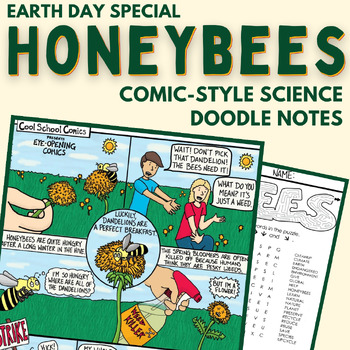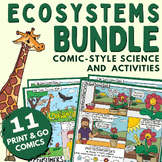Summer Word Search, Coloring Sheets, & Lesson - Help the Honeybees
- Zip
What educators are saying
Also included in
- With the ability to double as vivid science posters, this bundle of producers, consumers, decomposers, food chains, and food webs one-pager comics has it all! Use these one-pager comics as science coloring sheets, anchor charts, or reading passages. Teach your 5th-grade science class about ecosystemPrice $28.99Original Price $44.55Save $15.56
Description
If you are searching for the perfect Earth Day word search, lesson, or coloring sheet, this Help the Honeybees Earth Day Science Comic has the activities you have been searching for! This print & go resource is EASY to use and is great for both ELA and science classrooms!
Do you have a soft spot in your heart for honeybees and want to spread the word about protecting the species?
Are you looking for an engaging way to tackle environmental and conservation topics for Earth Day?
Read all about honeybees and the challenges they are facing. Readers will learn about colony collapse disorder (CCD), pesticide dangers, and the impact humans are having on the environment.
Overview
The honeybee population is quite unstable. All over our country, entire colonies are disappearing leaving. Aside from the fact that this affects our country's agricultural production, it indicates there is an imbalance in the ecosystem. No honeybees means no fruits, vegetables, and other crops. We need to do our part to help, and this comic makes it clear how easily we can accomplish this.
This comic marks the first in a series of "Eye Opening Comics." These comics will all be free and are all focused on topics that need to be brought to everyone's attention.
This Honeybees Earth Day Comic Includes
- Fully Colored Content Comic- Great for printing out as a handout, poster, or anchor chart
- Black and White Content Comic- Easy to print and unique addition to interactive notebooks
- Doodle Notes- Students fill in the blanks as they learn. Another great addition to interactive notebooks
- Earth Day Word Search and Activity Page
- Blank Comic Template with Rubrics allowing students to create their own Earth Day project.
- Answer Keys
Standards
MS.Human Impacts
- Human activities have significantly altered the biosphere, sometimes damaging or destroying natural habitats and causing the extinction of other species. But changes to Earth’s environment can have different impacts (negative and positive) on different living things. (MS-ESS3-3)
- Typically as human populations and per-capita consumption of natural resources increase, so do the negative impacts on Earth unless the activities and technologies involved are engineered otherwise. (MS-ESS3-3),(MS-ESS3-4)
More FREE Earth-friendly Comics!
Shark Week Comic- Save the Sharks.
*Doodle Notes is a trademarked term used with permission. Please visit www.Doodlenotes.org for more information.






